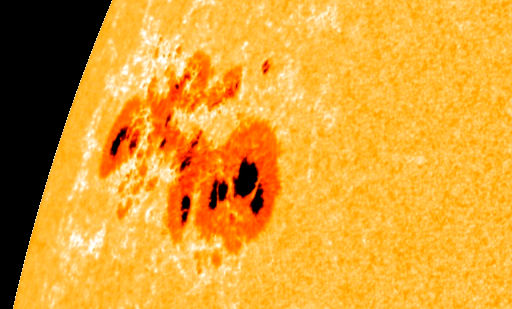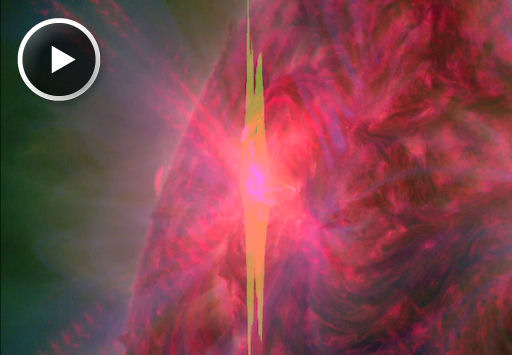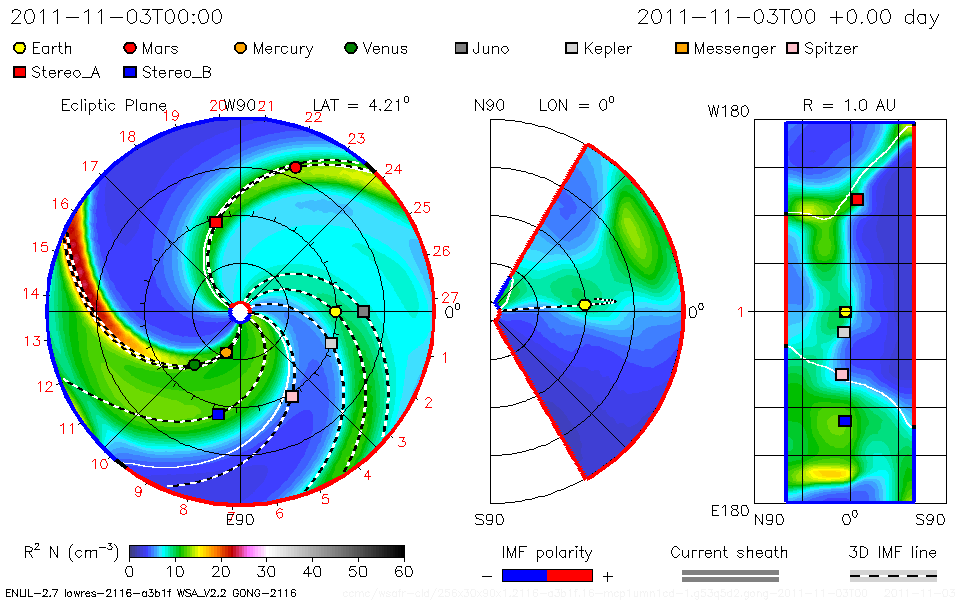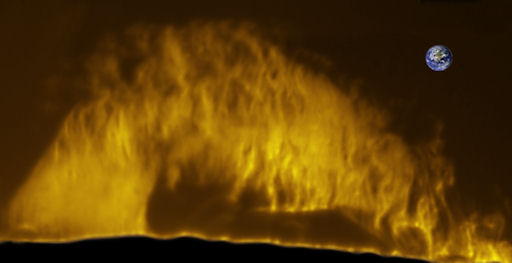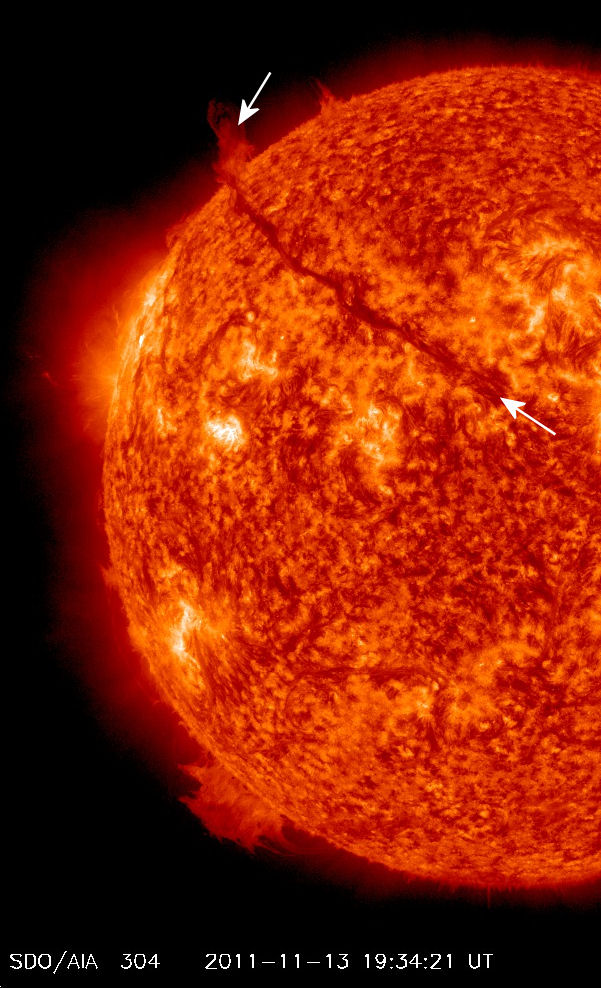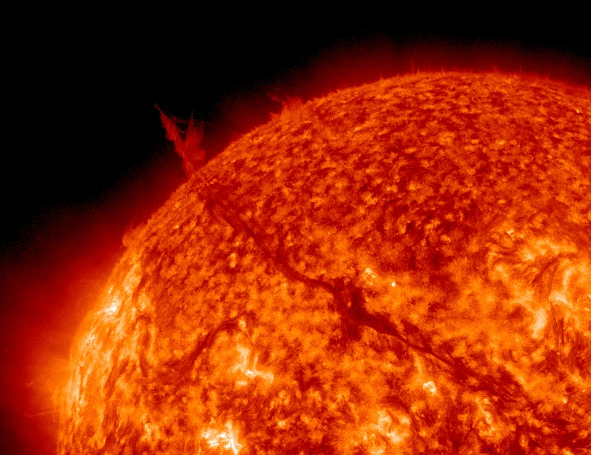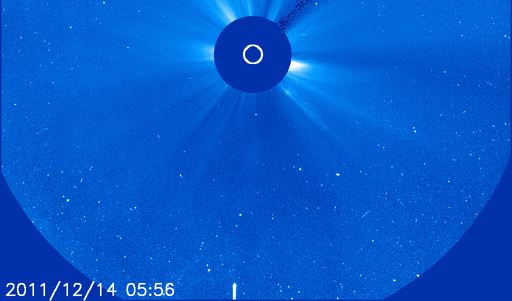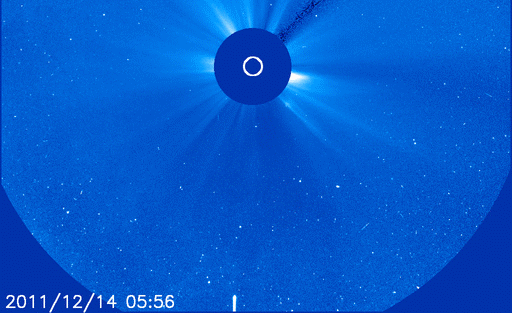WKN Weer, Klimaat en Natuurrampen
Lees alles over het onstuimige weer op onze planeet, volg orkanen en tornado's, zie hoe vulkanen uitbarsten en hoe Moeder Aarde beeft bij een aardbeving. Alles over de verwoestende kracht van onze planeet en tal van andere natuurverschijnselen.



Hm...40.000km groot... das 2x heen en terug naar Tokyo ofzoquote:BIG SUNSPOT: A large sunspot group is rotating over the sun's northeastern limb, possibly signaling an uptick in solar activity. NASA's Solar Dynamics Observatory took this picture during the early hours of Nov. 2nd:
Measuring some 40,000 km wide and at least twice that in length, the behemoth active region is an easy target for backyard solar telescopes. Astronomers are encouraged to monitor the region: NOAA forecasters estimate a 60% chance of M-class solar flares during the next 24 hours. Eruptions today would not be Earth directed, but future eruptions could be as the sunspot turns toward our planet in the days ahead.


quote:One of the largest sunspots in years is rotating over the sun's northeastern limb. NASA's Solar Dynamics Observatory took this picture of AR1339 during the early hours of Nov. 3rd:
Measuring some 40,000 km wide and at least twice that in length, the sprawling sunspot group is an easy target for backyard solar telescopes. Two or three of the sunspot's dark cores are wider than Earth itself.
Naturally, such a large sunspot has potential for strong flares. NOAA forecasters estimate a 50% chance of M-class solar flares during the next 24 hours. One such eruption has already occured: An M4-flare at 2200 UT on Nov. 2nd produced a bright flash of extreme UV radiation (SDO movie) and hurled a coronal mass ejection (CME) into space. The CME is not heading our way. Future CMEs could have greater effect as AR1339 turns toward Earth in the days ahead


X-FLARE: Earth-orbiting satellites have just detected an X2-class solar flare. The source is huge sunspot AR1339, described below. Stay tuned for updates. Solar flare alerts: text, voice.
[ Bericht 53% gewijzigd door blids op 03-11-2011 23:27:11 ]
[ Bericht 53% gewijzigd door blids op 03-11-2011 23:27:11 ]


Gisteren een M4.33
Vandaag een M2.59 en een X1.99
Het gaat weer de goede kant uit
Vandaag een M2.59 en een X1.99
Het gaat weer de goede kant uit
<a href="http://www.vwkweb.nl/" rel="nofollow" target="_blank">Vereniging voor weerkunde en klimatologie</a>
<a href="http://www.estofex.org/" rel="nofollow" target="_blank">ESTOFEX</a>
<a href="http://www.estofex.org/" rel="nofollow" target="_blank">ESTOFEX</a>


CHANCE OF FLARES: NOAA forecasters have upgraded the chance of X-class solar flares today to 20%. The source would be AR1339, one of the biggest sunspots in many years. The active region rotated over the sun's eastern limb two days ago and now it is turning toward Earth. Solar flare alerts:
The sunspot has already unleashed one X-flare on Nov. 3rd around 2027 UT. A movie from NASA's Solar Dynamics Observatory shows the extreme ultraviolet flash:
Bekijk filmpje op www.spaceweather.com
The flare created waves of ionization in Earth's upper atmosphere, altering the normal propagation of radio waves over Europe and the Americas. In Ireland, the flare's effect was felt even after dark.
A cloud of plasma or "CME" raced away from the blast site at 1100 km/s. The CME is not heading for Earth. It is, however, heading for Mercury and Venus. Click on the arrow to view a movie of the CME's forecast track:
[ Bericht 4% gewijzigd door -CRASH- op 04-11-2011 18:28:11 ]
The sunspot has already unleashed one X-flare on Nov. 3rd around 2027 UT. A movie from NASA's Solar Dynamics Observatory shows the extreme ultraviolet flash:
Bekijk filmpje op www.spaceweather.com
The flare created waves of ionization in Earth's upper atmosphere, altering the normal propagation of radio waves over Europe and the Americas. In Ireland, the flare's effect was felt even after dark.
A cloud of plasma or "CME" raced away from the blast site at 1100 km/s. The CME is not heading for Earth. It is, however, heading for Mercury and Venus. Click on the arrow to view a movie of the CME's forecast track:
[ Bericht 4% gewijzigd door -CRASH- op 04-11-2011 18:28:11 ]
<a href="http://www.vwkweb.nl/" rel="nofollow" target="_blank">Vereniging voor weerkunde en klimatologie</a>
<a href="http://www.estofex.org/" rel="nofollow" target="_blank">ESTOFEX</a>
<a href="http://www.estofex.org/" rel="nofollow" target="_blank">ESTOFEX</a>


quote:5 M-class solar flares in 24 hours
November 6, 2011 – Sunspot AR1339 is crackling with M-class solar flares, unleashing at least five of them in the past 24 hours. The blasts have been coming with such thick frequency that photographer Randy Shivak of Elyria, Ohio, was able to catch one in action on Nov. 5th: “Looking like iron filings around a bar magnet, sunspot group 1339 showed itself in the throes of a solar flare,” says Shivak. Even bigger eruptions are possible before the weekend is over. AR1339 has a delta-class magnetic field that harbors energy for X-class flares. The sunspot is turning toward Earth, so the odds of a geo-effective flare are increasing. Sunspot 1339 has a delta-class magnetic field that harbors energy for X-class solar flares.


CHANCE OF FLARES:
Big sunspot 1339 has quieted since a flurry of M-flares on Saturday,
but the active region still poses a threat for strong eruptions.
NOAA forecasters estimate a 70% chance of M-flares and a
10% chance of X-flares during the next 24 hours
www.spaceweather.com
Big sunspot 1339 has quieted since a flurry of M-flares on Saturday,
but the active region still poses a threat for strong eruptions.
NOAA forecasters estimate a 70% chance of M-flares and a
10% chance of X-flares during the next 24 hours
www.spaceweather.com
<a href="http://www.vwkweb.nl/" rel="nofollow" target="_blank">Vereniging voor weerkunde en klimatologie</a>
<a href="http://www.estofex.org/" rel="nofollow" target="_blank">ESTOFEX</a>
<a href="http://www.estofex.org/" rel="nofollow" target="_blank">ESTOFEX</a>


Een M1 klasse filamentuitbarsting op de zon, die gepaard ging met een grote
volledige halo CME, is op weg naar de Aarde. De aankomst is voorzien in de
nacht van 11 op 12 november en kan een kleine kans op poollicht veroorzaken
voor de Lage Landen.
Meer info over de poollichtkans op ons forum:
http://www.spaceweatherlive.com/community/index.php?topic=3149.0
volledige halo CME, is op weg naar de Aarde. De aankomst is voorzien in de
nacht van 11 op 12 november en kan een kleine kans op poollicht veroorzaken
voor de Lage Landen.
Meer info over de poollichtkans op ons forum:
http://www.spaceweatherlive.com/community/index.php?topic=3149.0
<a href="http://www.vwkweb.nl/" rel="nofollow" target="_blank">Vereniging voor weerkunde en klimatologie</a>
<a href="http://www.estofex.org/" rel="nofollow" target="_blank">ESTOFEX</a>
<a href="http://www.estofex.org/" rel="nofollow" target="_blank">ESTOFEX</a>


quote:REMARKABLE SOLAR ACTIVITY: There haven't been any strong solar flares in days. Nevertheless, some impressive activity is underway on the sun. For one thing, an enormous wall of plasma is towering over the sun's southeastern horizon. Stephen Ramsden of Atlanta, Georgia, took this picture on Nov. 11th:
"Solar forums all over the world are buzzing with Sun-stronomers proclaiming this to be the biggest prominence that many of them had ever witnessed," he says.
Remarkably, though, this is not the biggest thing. A dark filament of magnetism is snaking more than halfway around the entire sun: SDO image. From end to end, it stretches more than a million km or about three times the distance between Earth and the Moon. If the filament becomes unstable, as solar filaments are prone to do, it could collapse and hit the stellar surface below, triggering a Hyder flare. No one can say if the eruption of such a sprawling structure would be Earth directed.
Bron: www.spaceweather.com


Nu zie je hoe klein we eigenlijk zijn 
<a href="https://www.youtube.com/channel/UCPueUwKfPaGH7v48LZlltkg" rel="nofollow" target="_blank">WSDokkum Youtube</a>


For the past few days, astronomers around the world have been monitoring a dark filament of magnetism sprawled more than 1,000,000 kilometers across the face of the sun. Make that 750,000 km. On Nov. 14th the filament snapped and flung a fraction of itself into space.
The eruption hurled a cloud of plasma into space, but not toward Earth. The only effect on our planet would be to disappoint observers hoping for a longer filament.
http://www.spaceweather.com


Bron: Spaceweatherquote:Comet Lovejoy (C/2011 W3) is diving into the Sun and furiously vaporizing as it approaches the stellar surface. The Solar and Heliospheric Observatory (SOHO) is recording the kamikaze plunge. “This is, without any doubt, the brightest sungrazing comet that SOHO has ever seen,” says comet researcher Karl Battams of the Naval Research Lab in Washington DC. The comet’s nucleus, thought to be twice as wide as a football field, will skim approximately 140,000 km (1.2 solar radii) above the solar surface on Dec. 15/16. At such close range, solar heating will almost certainly destroy the comet’s icy core, creating a cloud of vapor and comet dust that will reflect lots of sunlight. “If Comet Lovejoy gets as bright as magnitude -4 or -5, there is a tiny but non-zero chance that it could become visible in the sky next to the Sun,” says Battams. Indeed, something similar happened to Comet McNaught in January 2007 when it was visible in broad daylight: gallery. Standing in the shadow of a tall building to block the sun allowed the comet to be seen in blue sky nearby. “Comet Lovejoy will be reaching perihelion (closest approach to the sun) right around sunset on Dec. 15th for people in the US East, Central, Mountain, and Pacific time zones,” continues Battams. “Be alert for the comet to the left of the sun at that time.” Caution: Do not look at or near the sun through unfiltered optics; focused sunlight can seriously damage your eyes. Discovered on Dec. 2nd by amateur astronomer Terry Lovejoy of Australia, the comet is an unusually large member of the Kreutz family. Kreutz sungrazers are fragments of a single giant comet (probably the Great Comet of 1106) that broke apart back in the 12th century. SOHO sees one plunging into the Sun every few days, but most are small, no more than 10 meters wide. Comet Lovejoy is at least ten times larger than usual


Weer wat plaatjes erbij
De komeet was overdag zichtbaar.....
"Comet Lovejoy will be reaching perihelion (closest approach to the sun) right around sunset on Dec. 15th for people in the US East, Central, Mountain, and Pacific time zones," continues Battams. "Be alert for the comet to the left of the sun at that time." Caution: Do not look at or near the sun through unfiltered optics; focused sunlight can seriously damage your eyes.
De komeet was overdag zichtbaar.....
"Comet Lovejoy will be reaching perihelion (closest approach to the sun) right around sunset on Dec. 15th for people in the US East, Central, Mountain, and Pacific time zones," continues Battams. "Be alert for the comet to the left of the sun at that time." Caution: Do not look at or near the sun through unfiltered optics; focused sunlight can seriously damage your eyes.
<a href="http://www.vwkweb.nl/" rel="nofollow" target="_blank">Vereniging voor weerkunde en klimatologie</a>
<a href="http://www.estofex.org/" rel="nofollow" target="_blank">ESTOFEX</a>
<a href="http://www.estofex.org/" rel="nofollow" target="_blank">ESTOFEX</a>


COMET LOVEJOY SURVIVES:
Incredibly, sungrazing Comet Lovejoy has survived its close encounter with the sun. Lovejoy flew only 140,000 km over the stellar surface during the early hours of Dec. 16th. Experts expected the icy sundiver to be destroyed. Instead, NASA's Solar Dynamics Observatory caught the comet emerging from perihelion (closest approach) apparently intact:
[ Bericht 22% gewijzigd door -CRASH- op 17-12-2011 00:11:18 ]
Incredibly, sungrazing Comet Lovejoy has survived its close encounter with the sun. Lovejoy flew only 140,000 km over the stellar surface during the early hours of Dec. 16th. Experts expected the icy sundiver to be destroyed. Instead, NASA's Solar Dynamics Observatory caught the comet emerging from perihelion (closest approach) apparently intact:
[ Bericht 22% gewijzigd door -CRASH- op 17-12-2011 00:11:18 ]
<a href="http://www.vwkweb.nl/" rel="nofollow" target="_blank">Vereniging voor weerkunde en klimatologie</a>
<a href="http://www.estofex.org/" rel="nofollow" target="_blank">ESTOFEX</a>
<a href="http://www.estofex.org/" rel="nofollow" target="_blank">ESTOFEX</a>


Door een uitbarsting op de Zon is een plasmawolk op weg naar de Aarde. Gisteravond produceerde de nieuwe zonnevlek 1387 een enorme zonnevlam. Daardoor zet een CME (Coronal Mass Ejection)of plasmawolk koers naar de Aarde en Mars. De wolk zou woensdag omstreeks 13 uur in botsing komen met het magnetisch veld van onze planeet.
Dat meldt de gespecialiseerde website spaceweather.com.
Volgens de website denken specialisten van de Amerikaanse weerdienst NOAA dat er woensdag 30 tot 40 procent kans is op een geomagnetische storm, wanneer de CME en inkomende stroom zonnewind (die niet met die plasmawolk gerelateerd is) snel na elkaar kunnen aankomen. In de nacht van woensdag op donderdag is er in hogere breedtegraden mogelijk poollicht te zien. Vanaf welke breedtegraad er echt kans is, is onduidelijk.
bron: volkskrant
Dat meldt de gespecialiseerde website spaceweather.com.
Volgens de website denken specialisten van de Amerikaanse weerdienst NOAA dat er woensdag 30 tot 40 procent kans is op een geomagnetische storm, wanneer de CME en inkomende stroom zonnewind (die niet met die plasmawolk gerelateerd is) snel na elkaar kunnen aankomen. In de nacht van woensdag op donderdag is er in hogere breedtegraden mogelijk poollicht te zien. Vanaf welke breedtegraad er echt kans is, is onduidelijk.
bron: volkskrant


Klink erg dramatisch dat artikel 
<a href="http://www.vwkweb.nl/" rel="nofollow" target="_blank">Vereniging voor weerkunde en klimatologie</a>
<a href="http://www.estofex.org/" rel="nofollow" target="_blank">ESTOFEX</a>
<a href="http://www.estofex.org/" rel="nofollow" target="_blank">ESTOFEX</a>


M1.52 onderweg
<a href="http://www.vwkweb.nl/" rel="nofollow" target="_blank">Vereniging voor weerkunde en klimatologie</a>
<a href="http://www.estofex.org/" rel="nofollow" target="_blank">ESTOFEX</a>
<a href="http://www.estofex.org/" rel="nofollow" target="_blank">ESTOFEX</a>


De eerste CME was vanmorgenvroeg
De tweede (zwakke) CMR komt vanavond/vannacht en de kans dat we
hier iets zien is gering tot niks
KP5
De tweede (zwakke) CMR komt vanavond/vannacht en de kans dat we
hier iets zien is gering tot niks
KP5
<a href="http://www.vwkweb.nl/" rel="nofollow" target="_blank">Vereniging voor weerkunde en klimatologie</a>
<a href="http://www.estofex.org/" rel="nofollow" target="_blank">ESTOFEX</a>
<a href="http://www.estofex.org/" rel="nofollow" target="_blank">ESTOFEX</a>


SOLAR FLARE:
Emerging over the sun's southeastern limb, sunspot AR1389 unleashed an M2-class solar flare at 1350 UT on Dec. 29th. The blast shows that the newly-visible sunspot is capable of significant eruptions. AR1389 is not yet facing Earth, but it is turning in our direction.
Emerging over the sun's southeastern limb, sunspot AR1389 unleashed an M2-class solar flare at 1350 UT on Dec. 29th. The blast shows that the newly-visible sunspot is capable of significant eruptions. AR1389 is not yet facing Earth, but it is turning in our direction.
<a href="http://www.vwkweb.nl/" rel="nofollow" target="_blank">Vereniging voor weerkunde en klimatologie</a>
<a href="http://www.estofex.org/" rel="nofollow" target="_blank">ESTOFEX</a>
<a href="http://www.estofex.org/" rel="nofollow" target="_blank">ESTOFEX</a>


FARSIDE BLAST:
A magnetic active region behind the sun's eastern limb erupted during the late hours of Jan. 6th.
SOHO recorded the flying debris. In a few days the blast site will rotate onto the
Earthside of the sun for closer inspection. Stay tuned.
A magnetic active region behind the sun's eastern limb erupted during the late hours of Jan. 6th.
SOHO recorded the flying debris. In a few days the blast site will rotate onto the
Earthside of the sun for closer inspection. Stay tuned.
<a href="http://www.vwkweb.nl/" rel="nofollow" target="_blank">Vereniging voor weerkunde en klimatologie</a>
<a href="http://www.estofex.org/" rel="nofollow" target="_blank">ESTOFEX</a>
<a href="http://www.estofex.org/" rel="nofollow" target="_blank">ESTOFEX</a>


Gaan wij daar nog iets van meekrijgen? Zo ja, hoe?quote:In a few days the blast site will rotate onto the Earthside of the sun for closer inspection.


Van deze CME niet(s)quote:Op zaterdag 7 januari 2012 22:26 schreef Nemephis het volgende:
[..]
Gaan wij daar nog iets van meekrijgen? Zo ja, hoe?
Maar dan kunnen ze waarschijnlijk de oorzaak ervan achterhalen
<a href="http://www.vwkweb.nl/" rel="nofollow" target="_blank">Vereniging voor weerkunde en klimatologie</a>
<a href="http://www.estofex.org/" rel="nofollow" target="_blank">ESTOFEX</a>
<a href="http://www.estofex.org/" rel="nofollow" target="_blank">ESTOFEX</a>


Ah duidelijk. senk joequote:Op zaterdag 7 januari 2012 22:33 schreef -CRASH- het volgende:
[..]
Van deze CME niet(s)
Maar dan kunnen ze waarschijnlijk de oorzaak ervan achterhalen

